Succulents are a good choice as indoor plants because they can live in dry conditions and relatively low humidity which otherwise are not a houseplant’s best friends. Let’s find the 10 best types of Succulents to grow indoors and how to cultivate these cushy plants.
The popularity of succulents has increased in the past few years as there are hundreds of distinctive varieties and are easy to grow even for beginners. Succulents survive in dry air and warm temperatures of most homes and adapt completely to the life inside and are easily available at nurseries and garden centers.
A dash of healthy greens in any room can make it more pleasant and fresh. Also, they filter air thus, making the living area healthier.
10 Best Types Of Succulents To Grow Indoors
This is a fact that all houseplants are not easy to grow, especially for the learners, so we’ve selected 10 best types of succulents to grow indoors that are popular and low maintenance as well.
-
Burro’s Tail (Sedum morganianum)
Burro’s tail or donkey tail is a flowering plant that belongs to the family Crassulaceae and is a native plant to southern Mexico and Honduras. It is a perennial succulent producing trailing stems growing up to 60 cm or even longer with blue-green plump leaves and bearing pink to red flowers in summers.
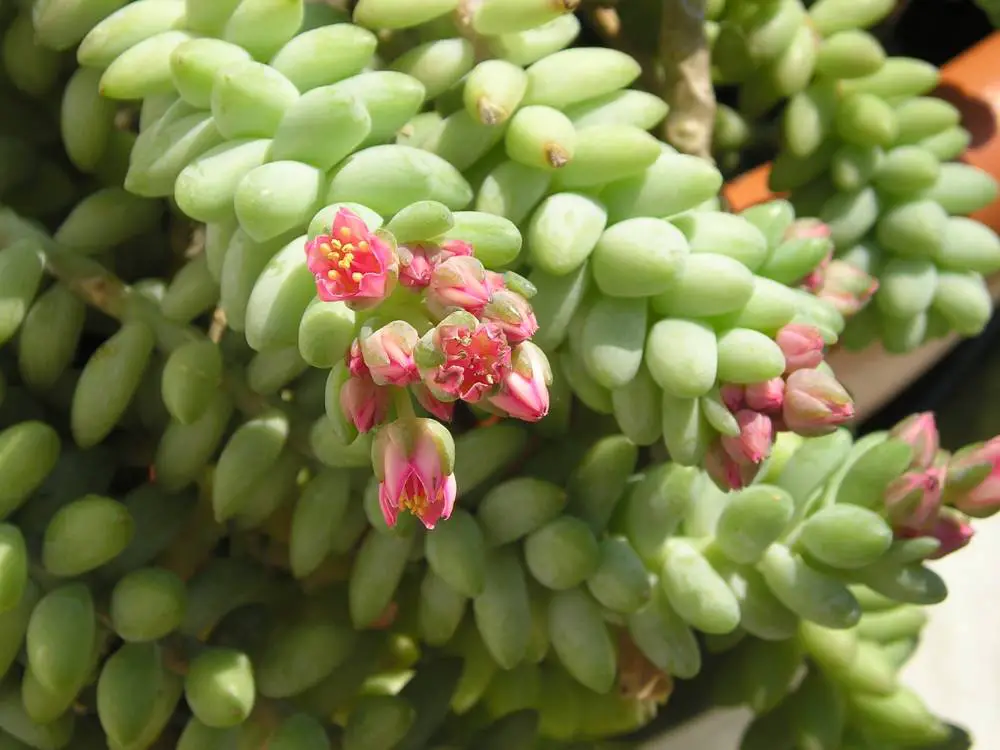
A mature plant can take 6 years to grow up to 4 feet in height. With fat trailing stems, Burro’s tail looks best when planted in hanging baskets or plant stands. This plant grows best when kept in bright sunlight and its beautiful blue-green leaves with pale sheen are of plump rice grain size.
The pale sheen on the leaves wipes off when touched, showing the fingerprints. The leaves are frail, fall off easily so avoid touching this plant as far as possible.
Allow the soil to dry between waterings, especially in winters when it doesn’t grow much.
Tips to take care of burro’s tail
Allow the soil to dry between watering and soil should be kept dry during winter dormancy.
Fertilize the plant once in summer with a cactus fertilizer.
Make sure that your plant acclimatizes well before you keep it outside for the summer sun.
-
Christmas Cactus (Schlumbergera)
The Christmas cactus is a houseplant that grows indoors and in the summers, it can be planted outdoors. With little care, this cactus will bloom during the onset of winters. It doesn’t have sharp spines and has flat, segmented, and fleshy stems and is also named as crab claw cactus.
Its drooping branches and rosy flowers give it a beautiful appearance and it releases oxygen at night rather than during the day, making it a good choice to keep it indoors.
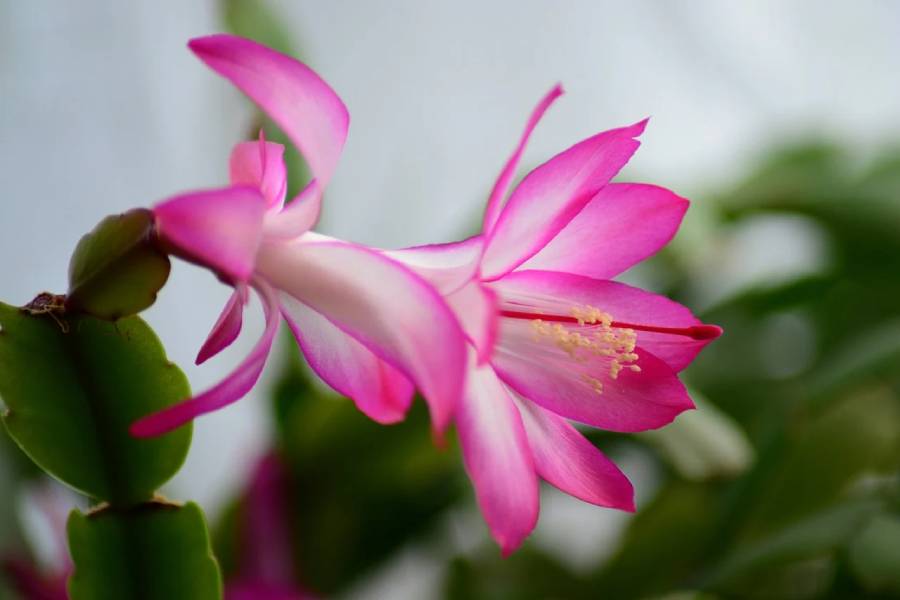
The soil should be moist when the plant is blooming.
East facing window is a good place to keep the cactus to provide moderate light and some direct sunlight.
As the buds are formed, administer a high-potassium fertilizer every two weeks.
To start the formation of flower buds, the plant requires a minimum of eight days of 16 hours of dark and eight hours of light each day. Make sure to expose your plant to darkness for a long duration and don’t turn the lights on at night, even for a short time period.
Tips To Take Care Of Christmas Cactus
For the growth of the Christmas cactus, let the soil dry up to 2 inches between watering spells.
Water the plant rarely during winters. When buds are formed, be very careful not to overwater or dehydrate the plant as it can result in falling buds.
-
Zebra Cactus (Haworthia fasciata)
Zebra Cactus is a fancy houseplants that is sometimes confused with Aloe and Gasteria plants. Haworthias are very small in size since they grow at a very slow pace.
Zebra haworthia has stunning stripes and spiky leaves that give it a rare and exotic appearance, but it is easily available at garden centers.
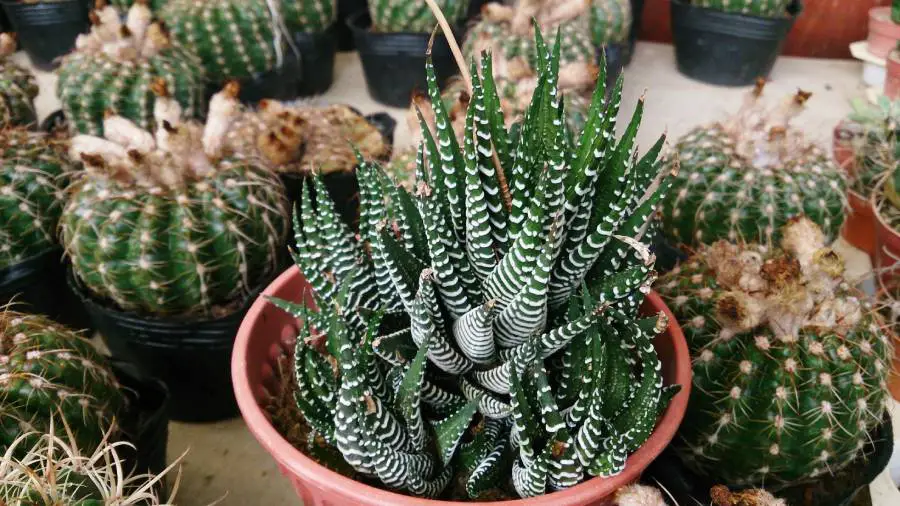
Keep it near a window where it can get a few hours of bright but indirect light daily, and the soil should dry out completely between waterings.
It is a native of the African continent, looks remarkable, occupies a small space, and needs little or no care.
Tips To Take Care Of Zebra Cactus
Use a shallow pot to grow zebra plants as the roots don’t go deep into the soil.
Repot it using fresh succulent potting mix at an interval of 12-24 months for maximum growth.
The soil should be almost dry between watering spells.
Place the zebra plant in a bright spot and don’t expose the plant to the direct sun or it will wither.
-
Aloe Vera ( Aloe barbadensis)
Aloe vera or Aloe barbadensis, is a medicinal plant with thick and short-stem that stores water in its long, slender leaves and is popular for treating skin injuries
As the plant grows, it gives rise to more groups of leaves called offsets that are large enough to fill the whole pot.
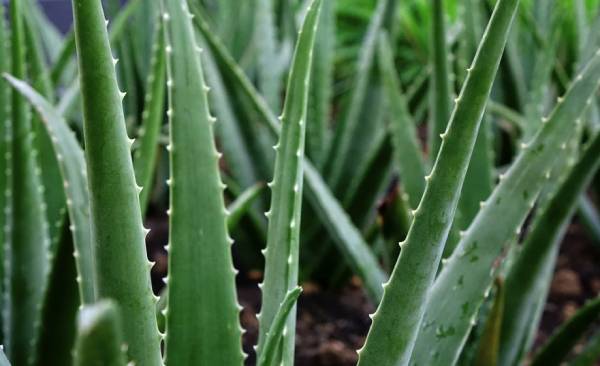
They are easy to separate from each other and can be shifted to other pots when it’s crowded. Aloe vera has been used for centuries to treat wounds and sunburn but it has sharp teeth along the edges of leaves that can injure if not handled with care. The soil should be dry rather than damp and it grows best in bright light, however, if you place it on a window where it gets direct summer sunlight , its leaves can get burned.
Tips To Take Care Of Aloe Vera
Allow the soil to dry between watering.
Place it where it can get sunlight for a few hours daily.
During the growing season, fertilize the plant twice using succulent fertilizer but there is no need for fertilizer in winters.
Do not repot until the roots grow out of the pot.
-
Crown of Thorns (Euphorbia milii)
The crown of thorns or Christ thorn or Christ plant is a flowering plant that belongs to the family Euphorbiaceae and is a native plant of Madagascar. Unlike its name, it is a beautiful succulent that can bloom throughout the year even indoors in sufficient sunlight. The spiky branches have long and spoon-shaped leaves along with small flowers. The flowers are not visible due to their small size and are green but are surrounded by attractive pink, white, yellow, or red bracts.
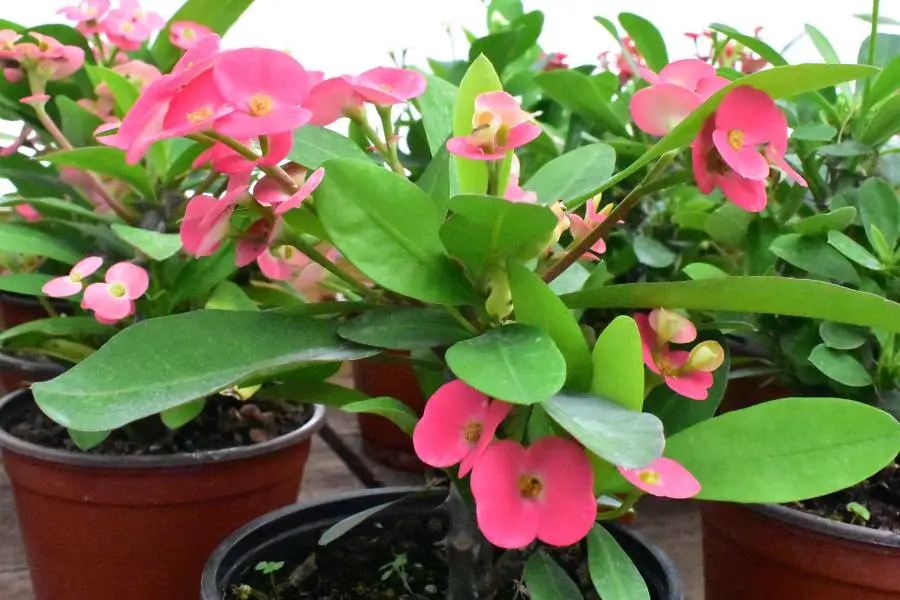
The crown of thorns can grow into a woody shrub and it is a perfect houseplant for most houses. It thrives best at room temperature and less humidity in the winter season.
One has to be cautious while growing Crown of Thorns as all parts of this plant are poisonous and even the honey made from the flowers of these plants can be toxic. Usually, cattle, horses, sheep, dogs, cats, and humans are impacted by Euphorbia and may suffer with acute irritation of the mouth and gastrointestinal tract, at times with hemorrhage and diarrhea
Tips To Take Care Of Crown of Thorns
A very adaptable houseplant, Crown of thorns requires a well-draining potting mix and the container or pot not more than about an inch or two larger than the roots. Avoid using excess soil as it can retain water and the roots will rot.
Sunlight for at least half a day is the other main requirement.
Crown of thorns grows best at 18C to 24C.
Water the plant moderately. Although the plant can adapt to medium-light conditions, the crown of thorns gives the best bloom in direct light.
During the growing season, fertilize 2-3 times with a fertilizer.
-
Hens-and-Chicks
Native to Europe and Africa, Hens and chicks are the succulents that belong to the Sempervivum group and are commonly called houseleeks. They grow well indoors and outside in cool or hot temperatures. Hens and chicks plants are given this name due to their rosette shape and as the plants produce many babies. Hens are the parent rosettes that appear in clusters and the smaller rosettes that arise from them are the chicks.
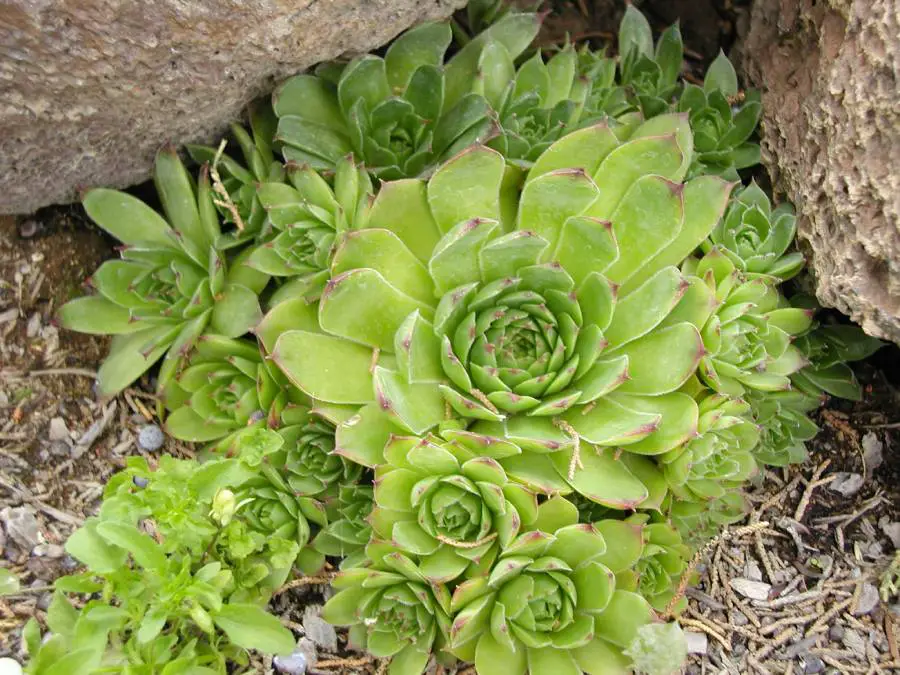
Hens and chicks spread fast to 2 feet or more in width by manual propagation or self-propagation. These are basically grown for their fascinating shape and succulent leaves which are mostly red, green, blue, gold, or copper in color. Hens and chicks bear flowers on a long stalk.
Tips To Take Care Of Hens and Chicks
As drought-bearing perennials, they can remain without water for weeks. However, newly transplanted plants need sufficient water to get established and once they’re, check the soil to ensure that it is dry before watering as constant moisture can rot their stems and roots. They flourish best in bright light near a window.
For propagation, remove the chicks and place them in a new pot and use a sandy potting mix so your plants will have the required drainage.
The Hens-and-Chick plants are great succulent plants for indoor gardening.
-
Panda Plant (Kalanchoe)
Kalanchoe tomentosa is a popular succulent plant grown indoors and is a native to Madagascar.
Panda plants have velvety, gray-green leaves that look like cat ears, hence the plant is named pussy ears. As a houseplant, they can reach a height of two feet and grow very slowly. Keep it in bright light near a window and allow the soil to dry between waterings. While watering the plant, don’t water the leaves or they may rot.
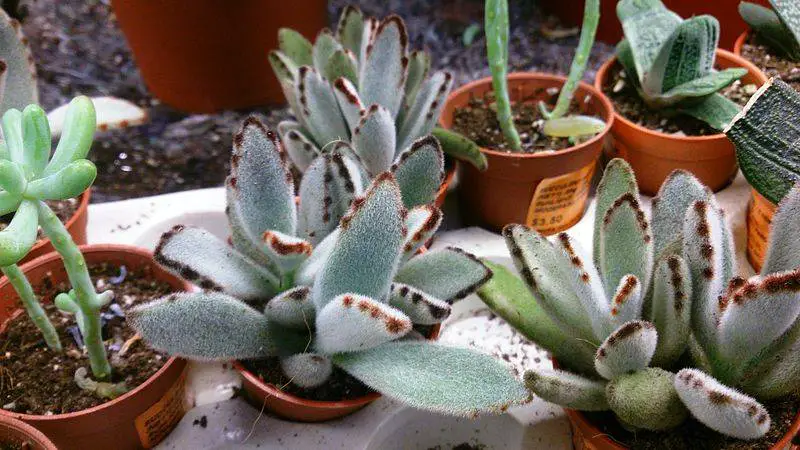
Tips To Take Care of Panda plant
If the plant is grown in a cooler region, water it rarely during winter dormancy.
Place these plants in bright light for better growth.
Propagate the plants by cuttings.
-
Jade Plant (Crassula ovata)
Jade plants are succulent house plants that are strong and easy to grow indoors.
They have thick, woody stems and oval-shaped glossy green leaves giving them a miniature, tree-like look that make them decorative houseplants.
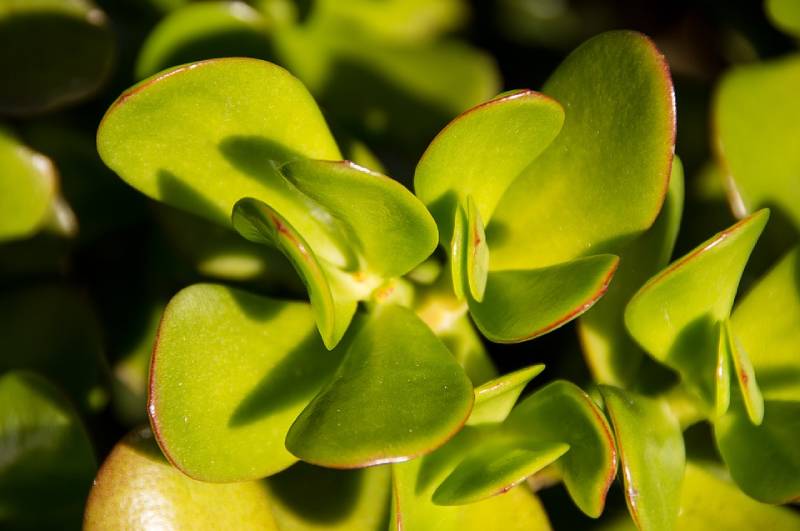
They live for a long time and reach heights of three feet or more when grown indoors. Their top part can become a bit heavy, so it is better to plant them in heavy containers. Let the soil dry completely between waterings.
Tips to Care for Jade Plants
Jade plants require a minimum of 4 hours of direct sunlight every day. Young plants need bright, indirect sunlight and well-established, big jade plants can cope with more direct sunlight. The south-facing window of kitchens and offices can be a great spot to place jade plants with enough light similar to the west-facing windows.
Jade plants grow best at room temperature at 18°C to 24°C.
Proper watering of jade plants is very important:
When the plant grows actively in spring and summer, it needs more water than the other times of the year. Water it deeply and wait till the soil has almost dried out before watering it again. Water it once a week or once a month and it depends totally on how fast the soil dries out.
Water it less often in winters and falls than in the spring and summer letting the soil dry out between waterings. One or two waterings throughout the entire dormancy period may be sufficient for well-established jades.
The plant needs more water if the leaves start to shrivel or develop brown spots.
If leaves are mushy and watered, the plant is getting too much water. Jade plants can be given a fertilizer made for cacti and succulents.
In winters, keep the plants away from windows.
-
Ponytail palm (Beaucarnea Recurvata)
Ponytail palm is not a real palm tree but is a succulent that looks somewhat like a palm tree and has a long, woody trunk and a bunch of leathery leaves at the top. It grows slowly and can reach a height of around four feet indoors. The bloated, round base of the trunk called caudex stores water, and hence the plant is named Elephant foot.

It grows best with bright light, low humidity, and warmer temperatures. It requires less water, especially in winters.
It is one of the most attractive and large houseplants that live longer and survive with the least care, make sure not to overwater them.
Tips to Care for Ponytail palm
It grows well in bright sunny spots.
Avoid watering regularly and allow the top soil to dry before watering it again
-
Snake Plant (Sansevieria trifasciata)
The snake plant is one of those plants known for both good looks and improving the air quality.
This succulent houseplant appears to be immortal as it can live without light and water for weeks without a change in its appearance. It is also called Mother-in-law’s tongue. The leaves are thick, pointed and firm, grow straight and can reach a height of three feet, and have patterned markings similar to a snake. It multiplies into a thick cluster that fills the pot and you can divide and repot when needed. Snake plants can tolerate low light but grow best in medium to bright light. A little water is required only when the soil is dry.
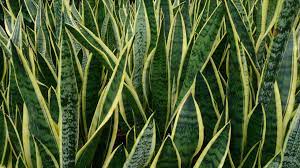
The snake plant is the most low maintenance plant in this list of ten best types of succulents to grow indoors as this succulent plant can survive even in the darkest of places with the least or no maintenance.
Snake plants can also help to filter indoor air by removing the toxic pollutants from the air, thus keeping you safe and healthy.
Tips to Care for Snake Plant
Water reasonably but don’t overwater.
Indirect sunlight is best for the snake plant.
You can place it in dark corners as a snake plant can thrive in any kind of atmosphere.
